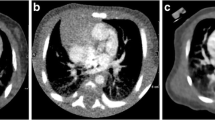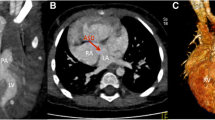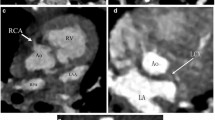Abstract
Background
Pediatric cardiac computed tomography (CT) can be acquired without electrode placement by using synthetic electrocardiogram (ECG).
Objective
To determine whether the depiction of gross cardiac structures and coronary arteries in 320-row pediatric CT is not inferior when CT is gated with synthetic ECG at 150 beats per minute (bpm), compared to the patients’ own ECG.
Materials and methods
Sixty 320-row CT examinations performed in children younger than 3 years old with congenital cardiac anomaly were enrolled in this retrospective study. Thirty examinations were scanned using the children’s own ECG for gating and 30 examinations were scanned using synthetic ECG at 150 bpm. The image quality was compared between the two gating modes using a 3-point scale to delineate the following anatomical structures: atrial septum, ventricular septum, right atrium, right ventricle, left atrium, left ventricle, main pulmonary artery, ascending aorta, aortic arch including the patent ductus arteriosus, descending aorta, right coronary artery and left main trunk. Beam-hardening artifacts from contrast enhancement material were evaluated using a 3-point scale, and the overall image quality was evaluated using a 5-point scale.
Results
Synthetic ECG was not inferior to the patients’ ECG in depicting each structure, beam-hardening artifact and overall image quality. Average indices were clinically acceptable imaging quality, except for subjective image quality of mid and distal coronary arteries.
Conclusion
Pediatric cardiac CT in patients younger than 3 years old can be acquired using synthetic ECG gating, with image quality not inferior to the patients’ ECG.




Similar content being viewed by others
References
Huang B, Law MW, Mak HK et al (2009) Pediatric 64-MDCT coronary angiography with ECG-modulated tube current: radiation dose and cancer risk. AJR Am J Roentgenol 193:539–544
Brenner D, Elliston C, Hall E, Berdon W (2001) Estimated risks of radiation-induced fatal cancer from pediatric CT. AJR Am J Roentgenol 176:289–296
Meinel FG, Henzler T, Schoepf UJ et al (2015) ECG-synchronized CT angiography in 324 consecutive pediatric patients: spectrum of indications and trends in radiation dose. Pediatr Cardiol 36:569–578
Herzog C, Mulvihill DM, Nguyen SA et al (2008) Pediatric cardiovascular CT angiography: radiation dose reduction using automatic anatomic tube current modulation. AJR Am J Roentgenol 190:1232–1240
Einstein AJ, Elliston CD, Arai AE et al (2010) Radiation dose from single-heartbeat coronary CT angiography performed with a 320-detector row volume scanner. Radiology 254:698–706
Zhang T, Wang W, Luo Z et al (2012) Initial experience on the application of 320-row CT angiography with low-dose prospective ECG-triggered in children with congenital heart disease. Int J Cardiovasc Imaging 28:1787–1797
Al-Mousily F, Shifrin RY, Fricker FJ et al (2011) Use of 320-detector computed tomographic angiography for infants and young children with congenital heart disease. Pediatr Cardiol 32:426–432
Yamasaki Y, Kawanami S, Kamitani T et al (2018) Free-breathing 320-row computed tomographic angiography with low-tube voltage and hybrid iterative reconstruction in infants with complex congenital heart disease. Clin Imaging 50:147–156
Shirota G, Maeda E, Namiki Y et al (2017) Pediatric 320-row cardiac computed tomography using electrocardiogram-gated model-based full iterative reconstruction. Pediatr Radiol 47:1463–1470
Maeda E, Yamamoto K, Kanno S et al (2016) Diagnostic phase of calcium scoring scan applied as the center of acquisition window of coronary computed tomography angiography improves image quality in minimal acquisition window scan (Target CTA Mode) using the second generation 320-row CT. ScientificWorldJournal 2016:1017851
Winkler MA, von Herrmann PF, Brooks MA et al (2013) Synthetic ECG-gated cardiac computed tomography for in vivo imaging of the temporary total artificial heart. Circulation 127:e4–e5
Kimiya T, Sekiguchi S, Yagihashi T et al (2017) Sedation protocol with fasting and shorter sleep leads to magnetic resonance imaging success. Pediatr Int 59:1087–1090
Deak PD, Smal Y, Kalender WA (2010) Multisection CT protocols: sex- and age-specific conversion factors used to determine effective dose from dose-length product. Radiology 257:158–166
Boone J, Strauss K, Cody D et al (2011) Size-specific dose estimates (SSDE) in pediatric and adult body CT examinations. Report of AAPM Task Group 204. College Park, Md: American Association of Physicists in Medicine
Saake M, Lell MM, Rompel O et al (2014) Contrast medium application in pediatric high-pitch cardiovascular CT angiography: manual or power injection? J Cardiovasc Comput Tomogr 8:315–322
Kundel HL, Polansky M (2003) Measurement of observer agreement. Radiology 228:303–308
Fleming S, Thompson M, Stevens R et al (2011) Normal ranges of heart rate and respiratory rate in children from the birth to 18 years of age: a systemic review of observational studies. Lancet 377:1011–1018
Author information
Authors and Affiliations
Corresponding author
Ethics declarations
Conflicts of interest
None
Additional information
Publisher’s note
Springer Nature remains neutral with regard to jurisdictional claims in published maps and institutional affiliations.
Rights and permissions
About this article
Cite this article
Maeda, E., Shirota, G., Shibata, E. et al. Comparison of image quality between synthetic and patients' electrocardiogram-gated 320-row pediatric cardiac computed tomography. Pediatr Radiol 50, 180–187 (2020). https://doi.org/10.1007/s00247-019-04541-y
Received:
Revised:
Accepted:
Published:
Issue Date:
DOI: https://doi.org/10.1007/s00247-019-04541-y




